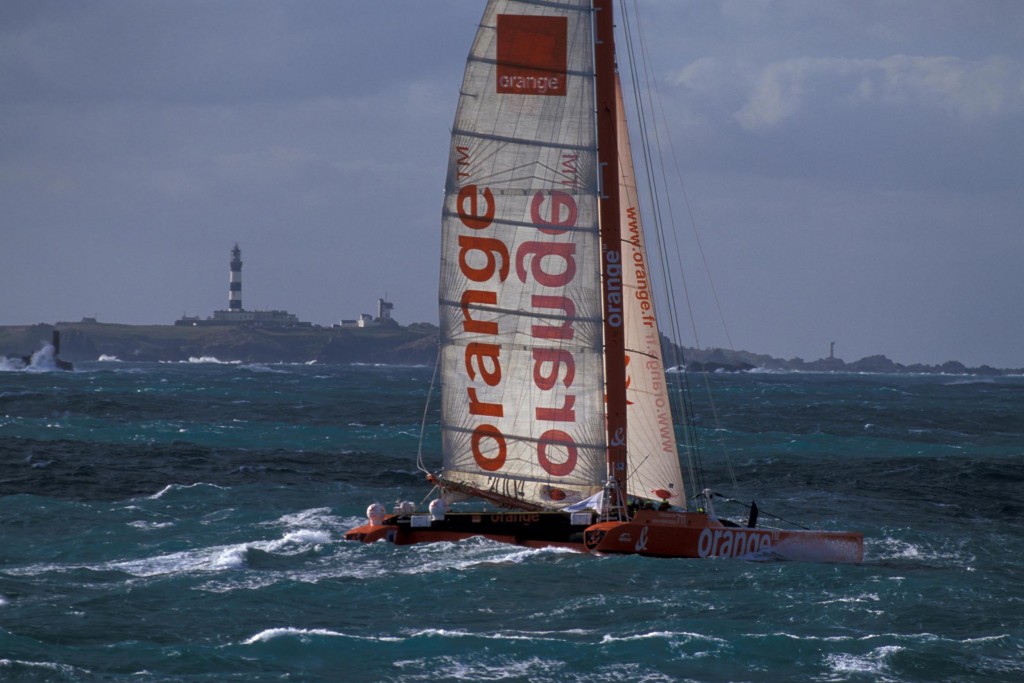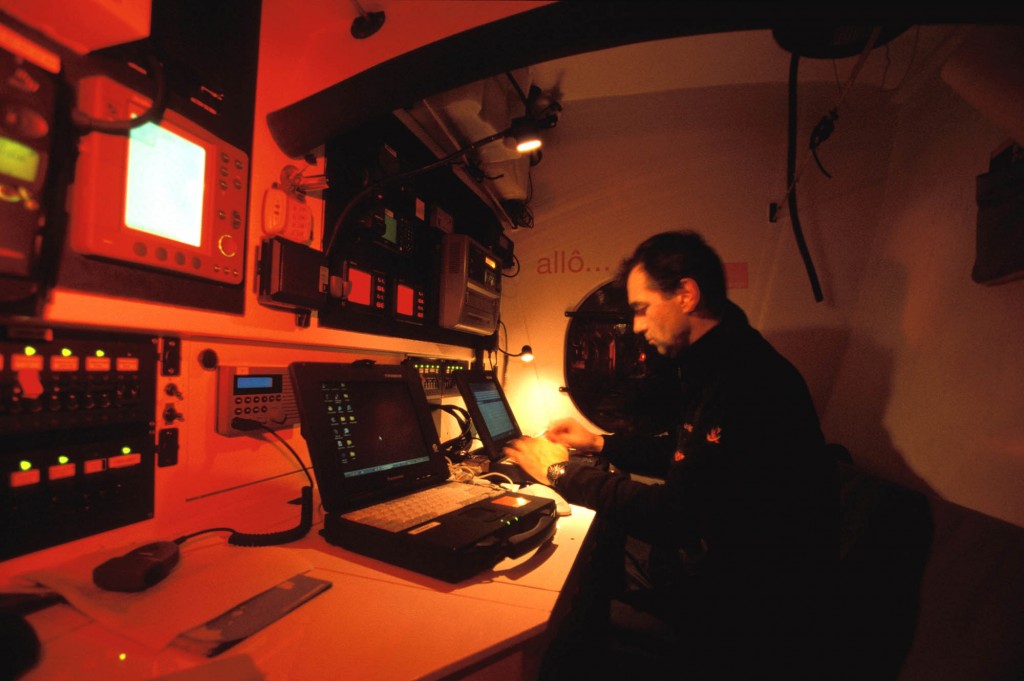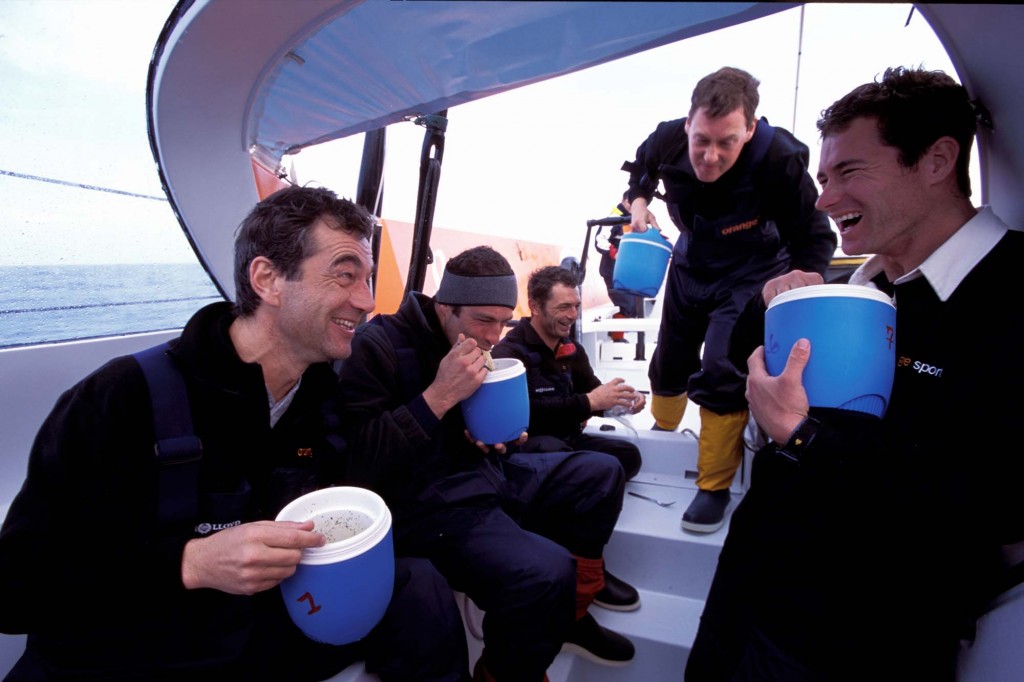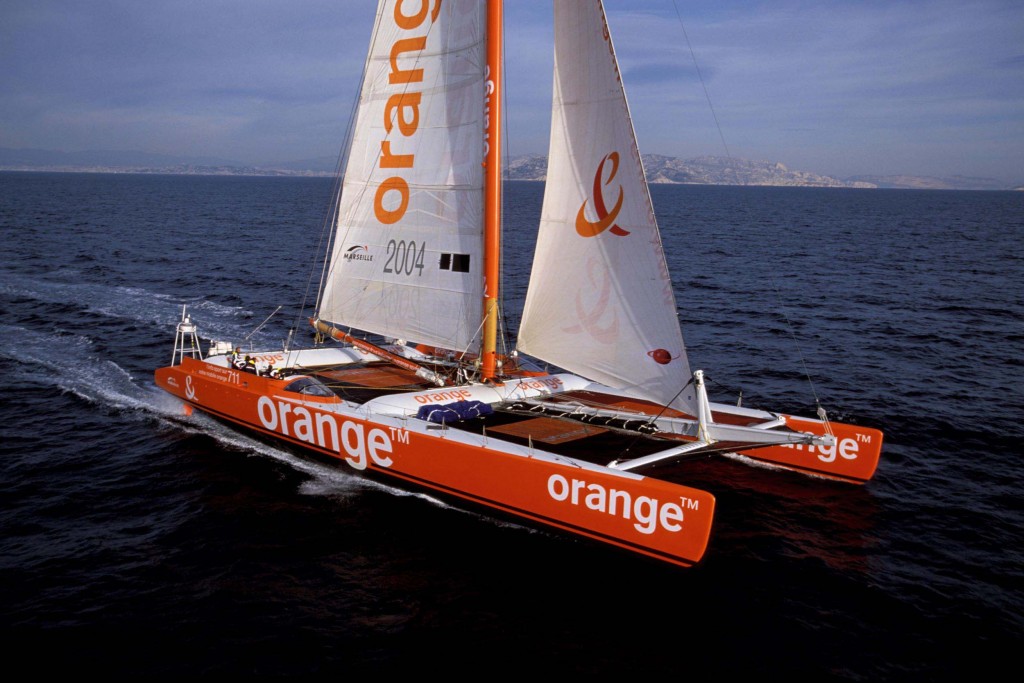Bruno Peyron / Orange
Almost ten years after his inaugural record, spurred on by Olivier de Kersauson’s performance in 1997, Bruno Peyron set off once again against Phileas Fogg’s watch. Thirteen sailors on board Orange maxi-catamaran would not be too many to thrash out this world tour. The weather was ruthless. The boat was close to breaking apart. The story of a hard-earned record… Ultimately won by sang-froid and tenacity.
 © Photo Gilles Martin-Raget
© Photo Gilles Martin-Raget
On 2 March 2002, the day on which Orange set off on the Jules Verne Trophy circuit, nothing heralded a comfortable victory. Bruno Peyron’s twelve men were worried. Already tested. Their maxi-catamaran’s masthead had broken after thirty minutes of sailing, on 14 February, during a first departure. Orange had just spent a dozen days in the good hands of the Multiplast yard in Vannes, for hasty repairs.
They could no longer afford to lose any more time. Rare are the optimal weather slots for reaching the equator and attempting a circumnavigation via the three capes in the best-possible conditions. The Great South is more navigable during the southern summer– winter in the northern hemisphere. Outside this period, setting a sailing speed record in these latitudes is highly unlikely.
Orange, 33 meters, was a new incarnation of the former Innovation Explorer, already victorious on an itinerary similar to that covered by the Jules Verne. In 2001, it had carried Loïck Peyron to second place in The Race, a circumnavigation event launched by his elder brother. But on board, even if the boat inspired confidence, everyone knew only too well that she needed pampering. As Orange crossed the starting line off Brest, whipping by at 20 knots, the wind northeasterly on a choppy sea, the eyes of all thirteen sailors were riveted on the masthead.
On the eve of this second departure, the crew learned that Geronimo, Kersauson’s trimaran, had turned around just after crossing the equator, due to rudder damage. “The Admiral” who had wanted to beat his own record had no choice but to abandon the race.
Gently to the equator
Heading for the equator, Orange maintained its average speed of 20 knots with a north-northeasterly wind that soon blew in the back axis of its trajectory.
Slowed down 80 miles (148 km) from this first geographical mark, the maxi-catamaran left untouched the Ushant-equator reference time recorded by ENZA New Zealand, skippered by Peter Blake and Robin Knox-Johnston in 1994.
When Orange entered the South Atlantic on the morning of 10 March, 7 days and 22 hours after crossing the Jules Verne Trophy’s starting line, Bruno Peyron was moved by memories of Peter Blake. The skipper from New Zealand had died tragically in 2001, in these same latitudes.
The South Atlantic barrier
On 11 March, Orange sailed along the South American coast and attempted to go westwards to bypass the St. Helena High. But the high-pressure zone stretched right up the South Atlantic, blocking the sailors’ way. “The anticyclone is swelling up more and more and is closing the door on us from east to west,” warned Gilles Chiorri. “We’re going to use up our first jokers on this first real ordeal…”
At 29°18 south, the Orange crew hoped to get their vessel to pick up speed and veer northward. But on 15 March, Philippe Péché, while inspecting the boat at the start of his shift, noticed a shiny object on the net: it was the mainsail’s headboard! The nine men on duty got busy on the repairs. And five hours later, by the time that the headboard car was fixed, the window for the highly anticipated exit from the anticyclone was shut.
The only option in the face of this South Atlantic barrage remained passing through the oceanic ridge: tackling the calm by cutting through, direction east-southeast, the center of the high pressures, while strong westerly winds blustered around 40° south.
A pitiless Indian Ocean
 © Photo Gilles Martin-Raget
© Photo Gilles Martin-Raget
On 21 March, after 18 days, 18 hours and 40 minutes at sea, in conditions hostile to navigational exploits, Orange set the Ushant – Cape of Good Hope benchmark time. It thus beat, by 23 hours and 13 minutes, the record set by ENZA in 1994, and came three days ahead of the time notched up by Sport-Elec in 1997.
The entrance into the Indian Ocean, at 39° south, set the tone for the rest of the course. “The sea was absolutely terrible last night,” reported Bruno on 22 March. “We’ve had 45 knots of wind since last night!” And those 45 knots (83 km/h) would whip up to 55 knots (102 km/h) the next day. Orange surfed at almost 40 knots. And even bare-poled, it continued at 20 knots!
Éric Mas, an analyst at Météo Consult, summed up the situation: “Behind Orange, a vast high-pressure zone is generating south winds. Impossible to go down, especially due to the sea’s unruly state. In front is a “wall” of depressions whose evolution at Orange’s latitude does not augur well for the next 24 hours.”
While the wind turned more favorable as of 28 March, the sea was not yet entirely in sync with the direction required by the boat. “With 25 knots and choppy seas, Orange is hitting it hard,” recounted Peyron. It was impossible to step things up without the risk of the boat blowing apart.
Even tamed, the maxi-catamaran persisted in covering 500 miles (926 km) per day. But disturbing damage was the price to pay for this speed – the breaking of two mainsail boards, delamination of part of the hull’s aft beam, and cracking of two bulkheads in the wave-impact zone – and the crew embarked on a huge slalom to find the ideal weather system. “We must be at our third system since the Cape of Good Hope,” sighed Hervé Jan, on 30 March.
Once again, despite adverse sailing conditions, Orange pocketed a reference time: Ushant-Cape Leeuwin, in the south of Australia, in 29 days, 07 hours and 22 minutes. Peyron’s crew had more than a day’s advance on the holder of the Jules Verne Trophy.
Pacific express
 © Photo Gilles Martin-Raget
© Photo Gilles Martin-Raget
On 5 April, shortly after crossing the anti-meridian at 53° south, Orange managed to change direction to head for the Great South. Now it needed to find a passage to avoid a calm zone between 50° and 60° south. In the north, the winds would be uncooperative: a wicked tropical low was forecast. The maxi-catamaran finally managed to pass below, downwind, using strong westerly winds that encouraged a cracking pace, boosted by a long swell.
The rediscovered headiness of fast speed and straight tracks – directly to the Horn – was interrupted by a cry of alarm on 10 April: “Iceberg straight ahead!” Through the fog, Philippe Péché, on the tiller, made out 3 miles (5 km) ahead, a block of ice the size of a cargo ship. Under staysail and single-reefed main, the maxi-catamaran was headed straight for it. The radar unnervingly tripped out at the same moment.
Yet it was not the Great South icebergs that would stop Orange, but the tropical low that arrested the attention of all hands on board during this crossing of the South Pacific. On 12 April, at 57° south, the low “bounced the boat from wave to wave and risked breaking something,” said Bruno Peyron. The mainsail was lowered, the gennaker rolled up and tucked away, the storm jib hoisted. “It’s a bit of a shame that our version of the Pacific Express is ending this way,” regretted the skipper. “But we’re here to bring back the Jules Verne Trophy and nothing else!”
Bruno Peyron’s choice to play the card of prudence since the start of the trip paid off. On 13 April, with four days on Olivier de Kersauson’s passage in 1996, the Orange crew crossed, in rainy conditions, the longitude of the last major cape marking the Jules Verne Trophy, the formidable Horn.
The Pacific Ocean was crossed in a record time: 12 days, 19 hours and 30 minutes. There were days in which Orange covered over 600 miles (1111 km) and it reached a peak of 39.7 knots. “She’s still intact after 42 difficult days at sea,” rejoiced the skipper.
Holy Mother, pray for us…
 © Photo Gilles Martin-Raget
© Photo Gilles Martin-Raget
The trip up the Atlantic forced the Orange crew to confront a new weather phenomenon: the complicated crossing of an anticyclone, with the threat of a violent low. Over eight days, Orange traced a long eastward trajectory, far more easterly than those followed by Jules Verne competitors at the time. The usual route was lengthened by 23%. But the low was well and truly avoided, and its 60-knot (111 km/h) winds skirted by 20 miles (37 km). The shortest way through the anticyclone was taken. On 22 April, Orange met the southeasterly trade winds that would carry it to the mouth of the Doldrums.
The passage of the equator, two days later, was the occasion on which Bruno Peyron announced much less encouraging news: “The titanium ball, 12 cm in diameter, that supports the 1,200 kg of the mast and rigging, with compression sometimes equal to over 60 tons, has cracked in its lower part around 170°. If it breaks, the mast will fall.”
The skipper decided to pursue the adventure nonetheless. The weather was hopeful. But if the boat were to return to Brest in one piece, it would now be necessary to avoid sailing into headwinds or against the swell at any cost. The crew also counted on chance and on bringers of luck including the sailors’ allies… “Tell our Marseilles friends to light a candle to the Holy Mother for the foot of our mast!” urged Bruno Peyron, during his radio séance on 26 April.
Did the patron saint of Marseille, Orange’s host port, hear the skipper’s request? The boat persevered, clocking up 460 miles (851 km) per day, and headed due north towards the Azores, avoiding the Azores High by the west. It even shortened the route followed in 1997 by Olivier de Kersauson.
Sailors, to the polls!
On land, another duel was being fought out: the French presidential election. On Sunday 5 May, Jacques Chirac was up against the far-right candidate, in the second and final round of the elections. French people made their resistance of extremism known in the streets. “As sailors, lovers of nature and freedom, we can only add a little strength to those who’ve been in the streets in recent days… We’re doing everything we can to be in Brest on Sunday to be able to go and vote,” promised Bruno Peyron.
On 4 May, only the final stretch remained. Orange cavorted, destination Ushant, at 25 knots, on port tack, under full main and solent.
On the previous day, there had been one last fright: the large gennaker had exploded into bits.
On the night between 4 and 5 May, a final meteorological test arose: the maxi-catamaran was trapped in calm seas 150 miles (277 km) from the final point of its world tour.
The thirteen Orange crewmembers had set off concerned about the masthead, and returned preoccupied with the mast’s foot… But it was a quasi-unscathed boat that crossed the finish line of the Jules Verne Trophy on 5 May, at 16 hours, 13 minutes, 45 seconds. Over 64 days, 08 hours, 37 minutes and 24 seconds, Bruno Peyron and his crew had never yielded to doubt. At an average of 18.15 knots, they established a new benchmark time for the Ushant – Ushant itinerary via the 3 major capes, in other words 28,035 miles (52,000 km). They improved on Olivier de Kersauson’s previous record by 7 days, 5 hours, 44 minutes and 44 seconds.
The last word goes to the skipper from Brittany: “Orange has just turned a fine sporting page. To succeed a venture such as the Jules Verne Trophy, it’s necessary to have a good team, a good boat, and to know how to preserve it. Bruno Peyron succeeded in doing this. The 27-meter era is over. This is the start of a new competition and it’s here to stay for a long time.”
8h | 37min | 24s
2002
2002-03-07
14H00
12°32 N
26°29 W
LOADING...
2002-03-17
14H00
35°26 S
18°18 W

LOADING...
2002-03-25
8H00
42°24 S
53°31E

LOADING...
2002-03-29
8H00
46°28 S
91°5 E

LOADING...
2002-04-09
8H00
54°18 S
131°48 W
LOADING...
2002-04-29
8H00
20°01 N
34°14 W
LOADING...
2002-05-05

LOADING...

